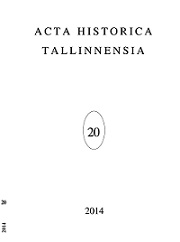TARTUSSE ASUTATAVA EESTLASTE KIRIKUVALITSUSEGA VABAKIRIKU EELNÕUST EESTI EVANGEELSE LUTERI USU VABA RAHVAKIRIKU ASUTAMISENI
FROM THE PROPOSAL TO ESTABLISH AN ESTONIAN FREE CHURCH GOVERNMENT IN TARTU TO THE ESTABLISHMENT OF THE ESTONIAN EVANGELICAL LUTHERAN CHRUCH
Author(s): Riho SaardSubject(s): History
Published by: Teaduste Akadeemia Kirjastus
Keywords: Estonia; Estonian History; ESTONIAN FREE CHURCH ; GOVERNMENT IN TARTU ; ESTABLISHMENT ; ESTONIAN EVANGELICAL LUTHERAN CHRUCH
Summary/Abstract: In terms of Lutheran church history, the gathering of delegates from Estonian congregations to the Church Congress in Tartu in the year 1917 was historically unique because it was the first event with such representation by Estonian Lutherans present. In the opinion of church historians and some other historians this event led to the establishment of an independent free folk church under the governance of Estonians in 1917. According to the church in Estonia (EELC) the date for this event is 31 May. In the opinion of the church abroad (E.E.L.C.) the date of the event is 1 June. In conclusion, the presentation of developments and points of view represented by this microstudy allows for an important correction to be made in the interpretation of events and the positions widely held by the church up to now. The enterprising activity untertaken by the clergy of Estonian congregations in the spring of 1917 should not be underestimated; but hindsight, one has to also recognize the impulses that the participants themselves did not necessarily see as directly or indirectly guiding their activity as observed by the historian in a retrospective view. The impulses influencing the delegates from Estonian congregations at the Church Congress in 1917 were the Provisional Government’s descision that the state and church should be separate as well as the initiative by which the Ministry of the Interior and the General Consistory of Russia planned to reorganize the Lutheran church according to nationality. These impulses produced a vital momentum so that in the second half of April 1917 the working out of a proposal for church governance for the Estonian congregations was begun. The Lutherans received an additional impulse from the Orthodox who had with an Estonian bishop moved in the direction of establishing an autonomous Estonian diocese as well as changing the Orthodox Church to be more Estonian in character. In Russia the various national Lutheran church congresses were intended to be preparatory events for a general synod of the Russian Evangelical Lutheran Church.
Journal: Acta Historica Tallinnensia
- Issue Year: 2014
- Issue No: 20
- Page Range: 096-131
- Page Count: 36
- Language: Estonian

